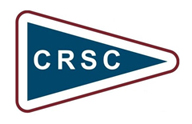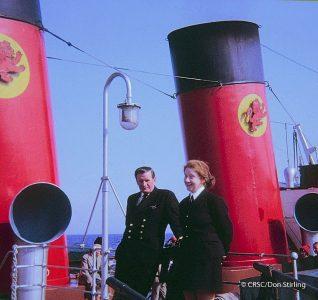
Waverley at Largs in 1973, showing paddle-box damage suffered during an encounter with Campbeltown pier on the CRSC charter of 15 September. She had been given funnel lions in 1965 and a black paddle-box with white rim in 1972, but 1973 was the only year she had a CalMac red-and-black funnel with lions affixed to a yellow disc. Don Stirling can be seen in officer’s cap on the forward sponson. He reckons two of the three individuals (one obscured) standing on top of the paddle-box are Douglas McGowan and Terry Sylvester, who were to play a pivotal role in the campaign to save the paddler for operational preservation
In a fascinating presentation on 12 November 2025, Don Stirling reminded CRSC members of the tribulations endured by Waverley in 1973, her only year under CalMac ownership. But we were also given insight into the paddler’s invaluable role as ‘maid of all work’ in a summer when the Clyde fleet was having to adapt hastily to the demands of a new era.
Andrew Clark summarises his impressions of the evening below, and paid-up CRSC members can watch a video of the complete 55-minute presentation by clicking here.

At the start of the evening Don Stirling was introduced by CRSC vice-president James Fisher (far right)
An almost audible collective gasp could be heard at CRSC’s latest gathering at the Maldron Hotel in Glasgow, at the point when Don Stirling concluded his assessment of Waverley under CalMac ownership: “It’s hard to believe she is still going after that litany of disaster.”
Don experienced most of Waverley’s 1973 disasters at first hand. He was her assistant purser throughout a summer that saw one problem after another, from boiler trouble to broken paddle-floats — not to mention the black cloud of threatened withdrawal.
The closure of Craigendoran pier in 1972 (when Don spent the summer on Maid of Argyll) had led to the disposal of two ‘Maids’, severely reducing passenger capacity in 1973 on bread-and-butter ferry runs — on which the Clyde’s last two excursion steamers, Waverley and Queen Mary II, proved unexpectedly useful. Don recounted how, obliged to do a Largs-Millport shuttle on Easter Monday, Waverley notched up a total for the day of 3,438.
By quoting that figure and others, Don offered remarkable documentary evidence of Waverley’s ups and downs in a season for which scant factual detail survives: she almost certainly saw a greater variety of work on the Firth in 1973 than in any year since her entry into service in 1947.
Her complement of 1,350 (500 more than her 21st century limit) saw her shift 1,137 trippers on one early-season Gourock-Dunoon crossing and 1,100 on a Glasgow Fair sailing between Wemyss Bay and Rothesay — figures that put into perspective the 625-capacity of the ‘Maids’ (650 for the ‘ABC’ car ferries). On the first day of August Waverley carried a total of 3,304, and on Cowal Games Saturday a whopping 4,374.
At the other end of the scale, she would regularly traipse down to Brodick for the early Monday morning ‘death run’ to Ardrossan for the sake of only 60-odd punters.
Don calculated that by the end of the season Waverley had carried 216,411 passengers.
The figure would have been at least 10,000 higher if she hadn’t suffered so many interruptions due to boiler tube problems, when the unemployed Maid of Argyll was rushed back into service, triggering a hasty transfer of officers, deck crew and catering staff.
On Tuesdays and Thursdays Waverley alternated mornings and evenings on a Round Bute/Loch Goil itinerary. On Fridays she went to Tarbert.
At Greenock Fair she stood in for a broken-down Glen Sannox on the Gourock-Dunoon ferry, and on 31 July she deputised for a broken-down Queen Mary II on the cruise to Inveraray — one of a handful of occasions that summer when Waverley was sent to the extremities of the Firth.
Another was the CRSC charter of 15 September, when she crunched the pier at Campbeltown and had to limp home. She only once visited Glasgow — for a charter from Plantation Quay to Brodick and Holy Isle.
Don revealed that 1973 was the year when Waverley became something of a film star. In early August she featured in the BBC’s ‘Play Away’ starring musician Jonathan Cohen (a Waverley supporter and CRSC member to this day). On a mid August cruise to Tarbert she carried two banjo players who were filmed from a helicopter for ‘Clydescope’. And the day after the Paddle Steamer Preservation Society’s end-of-season ‘Five Lochs Cruise’ on 29 September, she circled the Firth between Gourock and Dunoon for a film for which Countess of Kempock (ex Breadalbane) served as ‘camera ship’.
The next day Waverley was laid up, “and we all know what happened then,” said Don, his tone of voice suddenly turning wistful.
Between 1974 and 1978 Don enjoyed summer spells working on Clansman, Cowal, Glen Sannox, Jupiter, Juno and Bruernish (plus a single day on Queen Mary). He then qualified as a surveyor and enjoyed a successful career as a lecturer at London’s City University, eventually settling in Bournemouth. But Waverley in CalMac colours clearly meant something special, helping to explain why Don’s memory of that far-off summer is as fresh as ever.
If you are a paid-up CRSC member, you can watch a video of Don Stirling’s 55-minute presentation here.
The next CRSC meeting is on 10 December at 7pm in the Maldron Hotel, when Gavin Stewart gives his President’s Address.
Published on 14 November 2025













